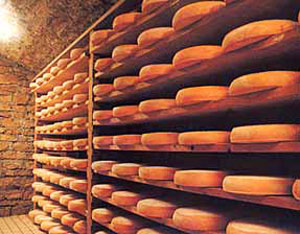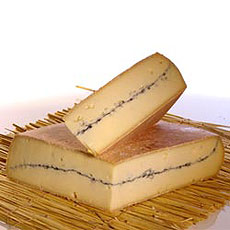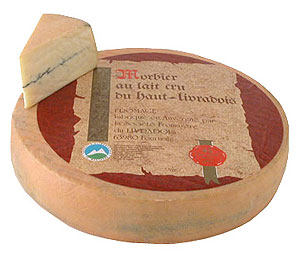Morbier Cheese
Page 2: How Morbier Cheese Is Made
This is Page 2 of a two-page article. Click on the black links below to visit Page 1.
How Morbier Cheese Is Made
To make Morbier cheese, fresh milk is collected every day. It is placed in massive mixing kettles, into which lactic ferments are added. The milk is then allowed to rest for an hour, at which time the rennet is added, and the mixture gets heated to 100°F. Once the milk has curdled and become solid, the cheesemaker cuts it into small pieces, and mixes the curds. The next process is called délactosage in French: The whey is extracted from the kettle and is replaced by an equal part of salted water.
When it’s ready, the curd “bread” is cut and placed in round, flat molds.  Next, the cheese wheels are removed from the molds and cut in half, into two flat rounds. A layer of ash gets poured on top of one round, and the other round is placed on top of that. A plate of casein is then put on top of the cheese, and the cheese is placed in a press for a day. Finally, the cheese is transferred to a cellar to complete the aging process. While aging, the cheese is washed and rubbed with
salted water three to four times a week. The maturation period of A.O.C.-accredited Morbier is at least 45 days (though to be imported into the U.S., it must be aged for at least 60 days since the cheese is made from raw milk). Next, the cheese wheels are removed from the molds and cut in half, into two flat rounds. A layer of ash gets poured on top of one round, and the other round is placed on top of that. A plate of casein is then put on top of the cheese, and the cheese is placed in a press for a day. Finally, the cheese is transferred to a cellar to complete the aging process. While aging, the cheese is washed and rubbed with
salted water three to four times a week. The maturation period of A.O.C.-accredited Morbier is at least 45 days (though to be imported into the U.S., it must be aged for at least 60 days since the cheese is made from raw milk).
Then, this delicious cheese is ready to enjoy!
Photo: Wheels of Morbier aging. Courtesy of Fromage-Morbier.com.
Cheese Terms
Here are cheese terms relevant to this article. For more cheese terms, see our Cheese Glossary.
A.O.C. (Appellation d’Origine Contrôlée): Controlled designation of origin, the AOC mark guarantees, among other things, that the cheese originates from a specific region of France and has been produced in a traditional way.
Curds: Cheese is made of curds, which are obtained by curdling (coagulating) milk with rennet (an enzyme) or an acid such as lemon juice or vinegar; then draining off the whey. The milk solids become curds when an acid (vinegar, lemon juice) or enzymes are added.
Casein: The element of milk which solidifies when coagulation takes place. Caseins are insoluble milk proteins which form suspended masses in milk, and thus create emulsions.
Gruyère: Gruyère is both the name of one of the best-known Swiss cheeses and a general name for large cheeses made in France, such as Beaufort, Emmentaler and Gruyère de Comté.
Raw Milk Cheese: Cheese that has been made from milk that has not been pasteurized. The sale of raw milk cheeses is not allowed in the U.S., except those which have been aged 60 days or longer.
Rennet: Rennet is a coagulating enzyme that is added to milk as the first step in making cheese. The traditional source of rennet is the abomasum (fourth stomach or rennet stomach) of slaughtered, milk-fed new-born calves or other young ruminants. It is also possible to produce rennet from fungi.
*Prices and product availability are verified at publication but are subject to change. Shipping is additional. These items are offered by a third party and THE NIBBLE has no relationship with them. Purchase information is provided as a reader convenience.
Lifestyle Direct, Inc. All rights reserved. Images are the copyright of their respective owners.

|



 Next, the cheese wheels are removed from the molds and cut in half, into two flat rounds. A layer of ash gets poured on top of one round, and the other round is placed on top of that. A plate of casein is then put on top of the cheese, and the cheese is placed in a press for a day. Finally, the cheese is transferred to a cellar to complete the aging process. While aging, the cheese is washed and rubbed with
salted water three to four times a week. The maturation period of A.O.C.-accredited Morbier is at least 45 days (though to be imported into the U.S., it must be aged for at least 60 days since the cheese is made from raw milk).
Next, the cheese wheels are removed from the molds and cut in half, into two flat rounds. A layer of ash gets poured on top of one round, and the other round is placed on top of that. A plate of casein is then put on top of the cheese, and the cheese is placed in a press for a day. Finally, the cheese is transferred to a cellar to complete the aging process. While aging, the cheese is washed and rubbed with
salted water three to four times a week. The maturation period of A.O.C.-accredited Morbier is at least 45 days (though to be imported into the U.S., it must be aged for at least 60 days since the cheese is made from raw milk).